| Columns Retired Columns & Blogs |
Wish we had some locally to hear.
I measured the Estelon XB Diamond Mk II in Jim Austin's listening room. I used DRA Labs' MLSSA system and a calibrated DPA 4006 microphone to measure the farfield frequency response and an Earthworks QTC40 microphone for the nearfield and in-room responses. As the Estelon speaker weighs 150lb, I wasn't able to lift it off the floor to raise the measurement axis sufficiently high to move the early reflections back in time. (The tweeter is 36" from the floor.) Instead, I used a small jack that Wilson Audio Specialties had loaned JCA for his December 2021 review of the Alexx V loudspeaker; still, the presence of reflections (see later) meant that the FFT-calculated response had limited resolution in the midrange.
Estelon specifies the XB Diamond's voltage sensitivity as 87dB/2.83V, presumably at 1m. My B-weighted estimate was lower, at 84.4dB(B)/2.83V/m. I used Dayton Audio's DATS V2 system to measure the loudspeaker's impedance. The XB Diamond's impedance is specified as 6 ohms, with a minimum value of 3.5 ohms at 50Hz. The impedance magnitude (fig.1, solid trace) is higher than 6 ohms for almost the entire audioband, with a minimum value of 3.1 ohms at 53Hz. The electrical phase angle (dotted trace) is occasionally high, causing the effective resistance (EPDR, footnote 1), which is calculated from the combination of magnitude and phase angle, to drop below 3 ohms between 18Hz and 36Hz, between 49Hz and 82Hz, and between 2.23kHz and 4.33kHz. The lowest values of the EPDR are 1.24 ohms at 59Hz and 1.93 ohms at 3.07kHz. Owners of the Estelon XB Diamond should match the speakers with amplifiers that won't be fazed by low impedances.
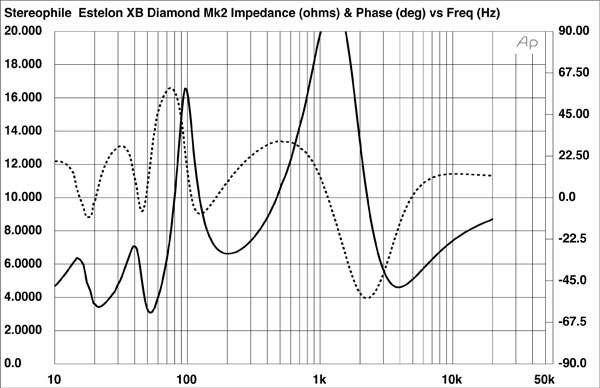
The impedance traces are free from the small wrinkles that would suggest cabinet resonances. Using a plastic-tape accelerometer, I found some low-level modes between 500Hz and 750Hz on all the enclosure's surfaces (fig.2). However, the low levels and relatively high frequency and Q (Quality Factor) of these modes make it unlikely that they'll have significant sonic consequences.
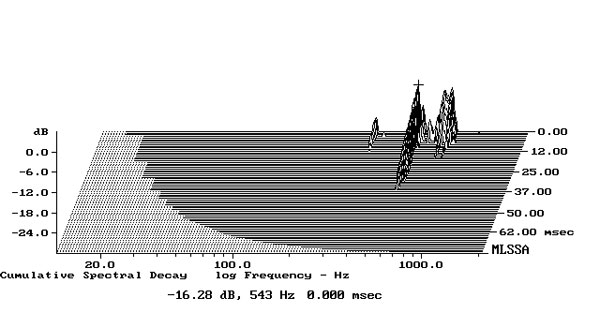
The saddle centered at 24Hz in the impedance magnitude trace suggests that the flared port on the rear panel is tuned to that frequency, which implies deep low-frequency extension. The port's output, measured in the nearfield (fig.2, red trace), peaked in that region but had a second peak at the same frequency where the woofer's nearfield output (fig.3, blue trace) was at its maximum. The port's output rolled off rapidly above 50Hz.
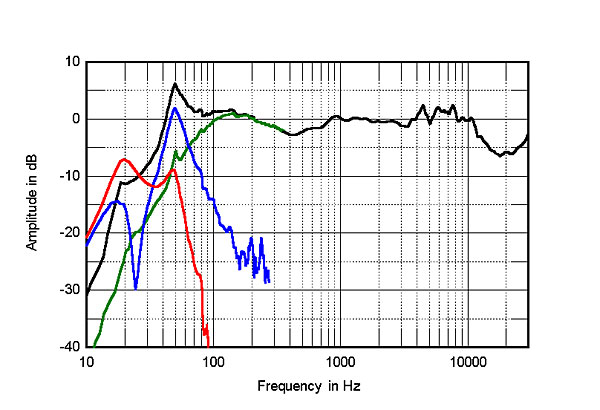
The woofer's nearfield response had the expected minimum-motion notch at the port tuning frequency and featured a very narrow passband, crossing over acoustically to the midrange unit (fig.3, green trace) at 65Hz. The crossover frequencies are not specified on Estelon's website, but the impedance peak at 95Hz suggests that the electrical woofer/midrange crossover is close to this frequency.
The black trace in fig.3 below 300Hz shows the complex sum of the XB Diamond's nearfield port, woofer, and midrange responses, taking into account their radiating areas, acoustic phase angles, and the fact that the port is on the rear panel. The midbass peak is due in part to the nearfield measurement technique, but the Estelon's low frequencies don't quite extend to the port-tuning frequency at full level. Higher in frequency in fig.3, the black trace shows the Estelon's farfield response averaged across a 30° horizontal window centered on the tweeter axis at 50". The trend is even up to 10kHz, though with a small lack of energy in the midrange and a slight excess in the octave above 4kHz. The response gently slopes down in the top audio octave. As with the Estelon Forza, which MF reviewed in October 2021, the XB Diamond's use of a pistonic tweeter with a high-Q ultrasonic dome resonance results in a lack of energy at frequencies just below that resonance.
To examine the loudspeaker's horizontal dispersion, I moved the microphone by 5° intervals up to 45° to the side of the tweeter axis. The Estelon XB Diamond maintains its spectral balance below 10kHz to the sides of the tweeter axis (fig.4), with the smooth, evenly spaced contour lines in this graph implying accurate, stable stereo imaging. (Reflections from the room's sidewalls will have the same spectral balance as the direct sound.) The dispersion plot in the vertical plane (fig.5) indicates that the tweeter-axis response is maintained over a wide ±10° window.
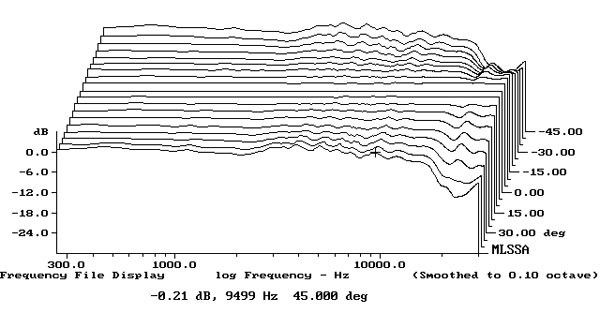
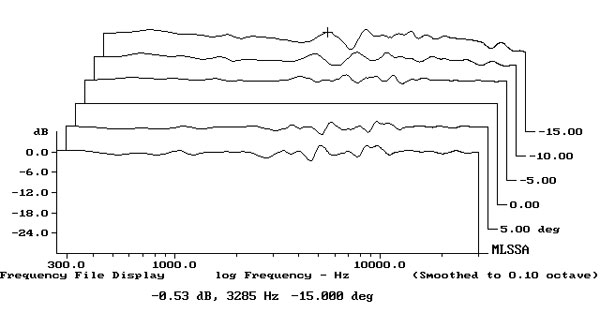
To examine the Estelon XB Diamond's spatially averaged in-room response (fig.6, red trace), I averaged 20 1/10-octave–smoothed spectra, taken with MLSSA for the left and right speakers individually, in a rectangular grid 36" wide × 18" high and centered on the approximate positions of JCA's ears. For reference, the blue trace in fig.6 shows the in-room response taken under identical conditions with the Wilson Alexx V. The two speakers excite low-frequency room resonances to a similar degree and behave similarly between 200Hz and 3kHz. Above that frequency, the Estelons have significantly more mid-treble energy than the Wilsons, which I could hear with the pseudo-random MLSSA noise signal as a touch of brightness. The responses of both speakers gently slope down above 5kHz due to their tweeters becoming more directional as the frequency increases and to the increased absorption by the room furnishings in the treble. (What you don't want to see with a spatially averaged in-room response is a flat treble output, which will sound excessively bright/shrill.)
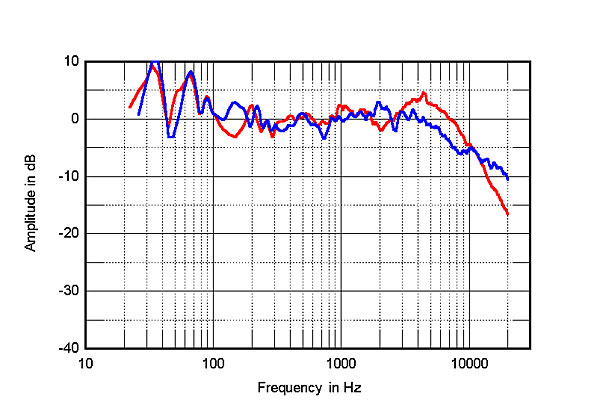
In the time domain, the step response on the tweeter axis at 50" (fig.7) reveals that the tweeter and midrange unit are connected in positive acoustic polarity, the woofer in negative polarity. (I confirmed this by looking at the individual step responses of each unit.) The decay of the tweeter's step smoothly blends with the positive-going start of the midrange unit's step; the decay of the midrange unit's step blends smoothly with the negative-going start of the woofer's step. The early reflections of the upper-frequency drivers' outputs that I mentioned earlier can be seen just after the 7ms mark in this graph.
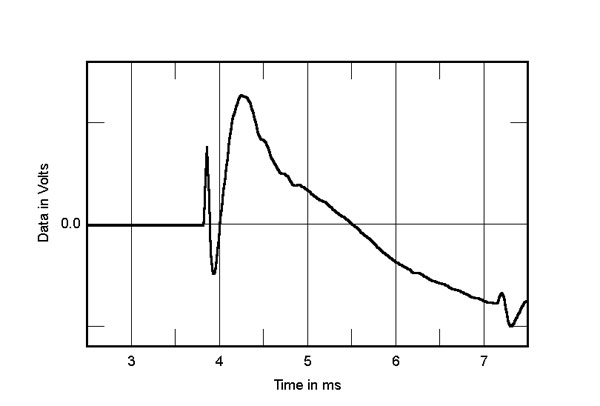
Finally, the cumulative spectral-decay or waterfall plot at 50" on the tweeter axis (fig.8) shows a clean initial decay, but there is then some low-level hash present in the mid-treble region. Again, the XB Diamond behaves similarly in this respect to the Estelon Forza.
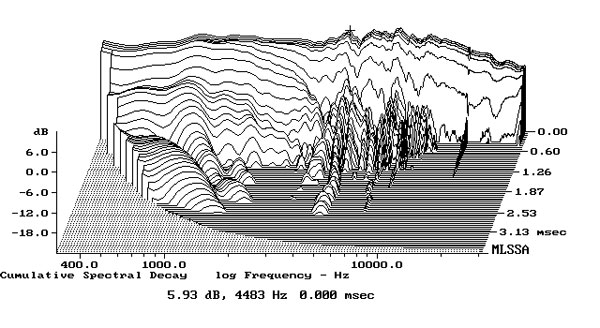
The Estelon XB Diamond Mk II's measured performance is very good overall, though that excess of mid-treble energy may complicate setup and system optimization.—John Atkinson

Wish we had some locally to hear.

Then the severe roll-off of both Wilson and these in the upper treble after 10khz, like the tweeters have been zobel'ed as they did back in the bell rigger old days of tweeters
Cheers George

Then the severe roll-off of both Wilson and these in the upper treble after 10khz, like the tweeters have been zobel'ed as they did back in the bell rigger old days of tweeters
From the in-room measurements text: "The responses of [the Estelon and Wilson] speakers gently slope down above 5kHz due to their tweeters becoming more directional as the frequency increases and to the increased absorption by the room furnishings in the treble. (What you don't want to see with a spatially averaged in-room response is a flat treble output, which will sound excessively bright/shrill.)
John Atkinson
Technical Editor, Stereophile

I wonder if they have to send royalties to the KEF Muon?
They look like 60% of a Muon.
If these were in my budget, I'd lust after them, for sure.

Yet JA the $28k KEF Blade Two Meta you measured a couple of months back are almost flat out to 20khz. No mention of them being excessively bright/shill.
https://www.stereophile.com/images/822kef.KEFB2Mfig4.jpg
Cheers George

That graph for the Blade 2 Meta is a near-field "anechoic" measurement while that for the Estelon and Wilson is "a spatially averaged in-room response." The Blade will also show some of the same roll-off if measured under those conditions.

"That graph for the Blade 2 Meta is a near-field "anechoic" measurement while that for the Estelon and Wilson is "a spatially"
We should have consistency in the way they are measured then, when these speakers are both measured just 2 months apart from each other but in different ways, all it serves to do is confuse matters to think there's something to hide or to confuse?
Cheers George

I think measurements are consistent. In-room, spatially averaged measurements are done when loudspeakers are so big or heavy they can’t be measured in JA’s lab. Regarding the blades, you should compare them with the semi-anechoic measurements of these ones.
Anyway, it would be nice to have a detailed description about where in the room those averaged measurements were taken, distance to loudspeakers, room size, reflections and treatment, etc.

There is consistency as the near-field "anechoic" measurement is always included and that appears as Fig.3 here for the Estelon.

they sound amazing. But just. So. Very. Ugly...

Got that right, But I'll add butt before ugly.
They look like salt and pepper shakers maybe??
Cheers George

https://dimg.dillards.com/is/image/DillardsZoom/zoom/nambe-kissing-salt--pepper-shaker-set/00466425_zi.jpg
I still like it, though!

on the shortcomings of overpriced speakers. well done.

...familiar with your drive-bys question if junior scientists could even begin to define over-priced in coherent terms. Of course, the same is probably true of coherent sound and probably even passable speakers, but we get the picture.
It's interesting - if numbingly boring - watching the junior scientist gang expel so much subjective, arbitrary, ignorant, and belief-based prose while at the same time exhibiting scant capacity for identifying better sound. You'd think that as a test of savviness and validity there'd be a linear relationship between walk and talk.
But there isn't. This being a bona fide high end publication, that latter at least should alert them. It won't either, but in a rational, civil world, it would. Listening with graph paper it is.

https://www.parts-express.com/speaker-components/speaker-subwoofer-kits
Better now?

Thanks for the effort and great writing technique. However, I personally do not find much value in this review. What's the point of any review without a proper comparison? Say you don't have a good basis to compare it to other speakers in the similar price range, then why don't you pass it to someone in your editorial team who has the right background? Sure, there are some value to be found on entirely subjective review. But, isn't that just as good as any review on Amazon. What makes this review 'professional'? You had or still have Alexe V. I understand Alexe is much more expensive, but only comparison you had is just casually mentioning a hotter mid-treble and that's it. The only other comparison you have is one sentence about quirky space things about Alta Audio and Audio Vector. My take on this review is either Estelon XB Diamond does not worth much if compared to other top players in the price range. Or, it was so good it put Alexe V to the shame.

I paid Stereophile magazine subscription for over 6 years. Does that give me a little more right to complain? When you like something enough, I think people are bound to make a criticism time to time. Like your favorite sports team. Do you pay for anything therefore you complain?

...will run comparison panel tests of all dozen and a half types of $50,000-$75,000 audio products for you.
And $10,000-$25,000 and $25,000-$50.000 and $75,000-$100,000, and...

If you can afford the Alexe V or this Estelon, you don't need reviews.
Go listen for yourself.


What great news!

Though they sound incredible and are visually stunning their cabinet material is prone to chipping.
I was helping a local dealer fit his with their spikes and when we tilted the speaker to the side the edge of one slightly nicked the floor causing a nice size chunk to chip off. I was alarmed more than he was that a $85,000. Speaker could be damaged so easily.